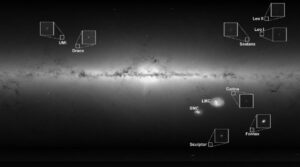DarkMatter Theory in Crisis After 2 Satellite’s Odd Size Explained: 1 Mystery Galaxy Solved!
A giant, faint galaxy challenges Cold Dark Matter theory. Its size and coldness can’t be explained by weak tidal forces. Self-Interacting Dark Matter offers a solution, suggesting dark matter interactions create a larger, cooler galaxy.
CONTENTS: 1 Mystery Galaxy Solved! DarkMatter Theory in Crisis After 2 Satellite’s Odd Size Explained

Cold galaxy challenges dark matter theory
DarkMatter Theory in Crisis After 2 Satellite’s Odd Size Explained
Crater 2, a large and faint satellite galaxy, presents characteristics that challenge traditional cold dark matter theories. The SIDM (Self-Interacting Dark Matter) theory offers a more suitable explanation, suggesting that interactions among dark matter particles reduce density and increase the galaxy’s size, aligning with observed data.
Located around 380,000 light years from Earth, Crater 2 is one of the largest satellite galaxies of the Milky Way. It is extremely cold and has slow-moving stars, leading to its low surface brightness. The origins of this galaxy remain unclear.
Challenges in Understanding Crater 2
“Since its discovery in 2016, numerous efforts have been made to replicate Crater 2’s unique properties, but it has been very challenging,” said Hai-Bo Yu, a professor of physics and astronomy at the University of California, Riverside. His team recently published a paper in The Astrophysical Journal Letters offering an explanation for Crater 2’s origin.
A satellite galaxy orbits a larger host galaxy. Dark matter, which constitutes 85% of the universe’s matter, can form a spherical structure known as a dark matter halo due to gravitational forces. This invisible halo surrounds and permeates a galaxy like Crater 2. The extremely cold nature of Crater 2 suggests its halo has a low density.
Weak tides challenge cold dark matter
Yu explained that Crater 2 evolved within the Milky Way’s tidal field, experiencing tidal interactions with its host galaxy similar to the tidal forces Earth’s oceans experience due to the Moon’s gravity. Theoretically, these tidal interactions could reduce the density of the dark matter halo.
However, recent measurements of Crater 2’s orbit around the Milky Way suggest that the tidal interactions are too weak to lower the dark matter density of the satellite galaxy to levels consistent with observations if dark matter consists of cold, collisionless particles, as proposed by the prevailing cold dark matter (CDM) theory.
Self-interacting dark matter explains large galaxy
DarkMatter Theory in Crisis After 2 Satellite’s Odd Size Explained: Yu highlighted another puzzle regarding Crater 2’s size, given that tidal interactions typically reduce a satellite galaxy’s size as it evolves within the Milky Way’s tidal field.
Proposing a New Theory: SIDM
Yu and his team propose a different theory, known as self-interacting dark matter (SIDM), to explain Crater 2’s unique properties and origin. SIDM posits that dark matter particles interact with each other through a dark force, leading to strong collisions near the center of galaxies.
“Our research demonstrates that SIDM can account for the unusual characteristics of Crater 2,” Yu explained. “The key mechanism involves self-interactions among dark matter particles, which thermalize the galaxy’s halo and create a shallow density core. In contrast, a cold dark matter (CDM) halo would exhibit a steep increase in density toward the galaxy’s center.”
According to Yu, in SIDM, even a relatively weak level of tidal interactions, as inferred from Crater 2’s orbital measurements, can sufficiently lower the galaxy’s dark matter density to match observations.
“Crucially, SIDM predicts an expansion in galaxy size, which aligns with Crater 2’s large size,” Yu noted. “Dark matter particles are less tightly bound in a cored SIDM halo compared to a ‘cuspy’ CDM halo. Our findings indicate that SIDM offers a more robust explanation for the origin of Crater 2 compared to CDM.”
The study “Self-interacting Dark Matter Interpretation of Crater II” by Xingyu Zhang et al., published on June 10, 2024, in The Astrophysical Journal Letters, proposes that self-interacting dark matter (SIDM) offers a better explanation than traditional cold dark matter (CDM) theories for the unusual properties and origin of Crater 2. It suggests that SIDM’s ability to create a shallow density core through dark matter self-interactions can explain Crater 2’s large size and other observed characteristics.
Check out TimesWordle.com for all the latest news
You must be logged in to post a comment.